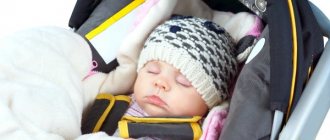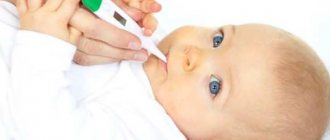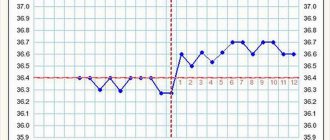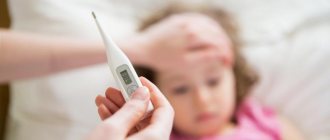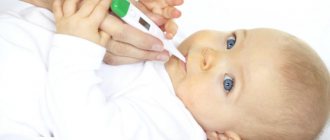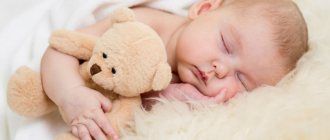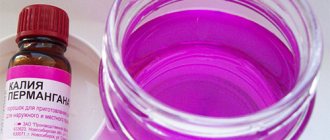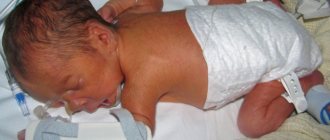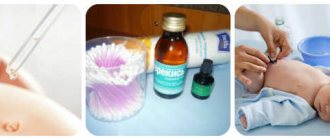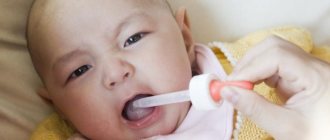When preparing for the birth of a baby, parents try to create comfortable conditions for their baby. In addition to buying a wide variety of things, it is worth considering in advance a system for maintaining optimal temperature in the room for a newborn. The baby should neither overheat nor freeze.
Based on the baby's behavior, you can find out what temperature and humidity is more comfortable for a newborn.
Temperature and humidity indicators in the child's room
According to modern medical standards, the optimal temperature in a room for a newborn should be between 18-20°C. With these indicators, all biological processes in the baby’s body occur naturally.
But! in my opinion it's too cold. An adult wants to wear woolen socks, wrap himself in a blanket and not stick his nose out of it. Therefore, in my practice, I guide parents to 22-24 degrees, and no deterioration in the child’s well-being is noticed.
Air humidity is also important for metabolism.
To monitor temperature data, place a thermometer next to the baby's crib. Humidity levels in the room are determined using a hygrometer, but it should be located away from heating appliances.
It is important to clearly understand the difference between the concepts of “room temperature and humidity” and “newborn discomfort.”
Each baby is individual, so you need to focus, first of all, on the baby’s well-being. If the temperature and humidity of the room are normal, and the newborn has cold and sweaty hands and feet, you should wear socks or an extra blouse.
Warm clothes, high temperature, lack of fresh air - the newborn sweats. Excessive skin moisture promotes the appearance and proliferation of bacteria.
In a stuffy room, the baby's sleep will be disrupted. Frequent waking up due to a feeling of thirst is reinforced reflexively over time. How to improve the sleep of a newborn, see the course: Peaceful sleep for a baby from 0 to 6 months.>>>
Correcting a wrong habit will require correction not only of the temperature regime, but also a lot of effort and patience from parents.
Normal temperature in an apartment: room temperature – how many degrees?
You need to figure out what temperature in the apartment will be considered optimal, according to government regulations.
It is indicated that:
- In a room, the acceptable temperature can be considered to be from 18 to 24 degrees, and the optimal temperature is from 20 to 22. Provided that the temperature outside is 30 degrees for 5 days, in the apartment it should be 20.
- In the kitchen and toilet, the optimal reading will be from 19 to 21, and 18-26 acceptable.
- If your bathroom is combined, then the optimal temperature here will be from 24 to 26 degrees, and the acceptable temperature will be 18-26.
Despite the established norms and standards, the temperature in the apartment may vary depending on the season. Its error can be 3 degrees down at night and up to 4 degrees at any other time of the day. A completely separate matter is the common corridor and landing. According to the regulations, here the indicator can be at least 15 degrees.
Thermoregulation control
A newborn baby sleeps about 20 hours a day. Its active activity is small, while all organs and systems work at their maximum. Metabolism is much faster than that of an adult.
The thermoregulation system has not yet been adjusted, so it is worth creating the most comfortable temperature in the room for the newborn.
Overheat
Parents make sure that their child does not catch a cold or cough. (Find out how to treat a cough in an infant?) At the same time, they get carried away with excessive dressing. Infant overheating is very dangerous, so you should not constantly put warm socks and hats on your baby if the temperature in the room is more than 18°C.
Hardening the body from childhood will help avoid frequent colds. How to raise a healthy child, see the course Healthy Child: Workshop for Mom>>>
At elevated temperatures, the baby has two ways of losing excess heat:
- Breath.
The inhaled air, reaching the lungs, heats up to body temperature. The difference in degrees reflects the amount of heat generated. The cooler the air in the room, the greater this loss will be. High air temperature in a child's room can lead to overheating of the young body.
- Sweating.
If it is impossible to regulate temperature in the first way, the second way is activated in the newborn - through the skin. Drops of sweat come to the surface.
Excessive body moisture is very dangerous. In this case, the body not only loses excess heat by lowering the temperature, but also the salts and water necessary for it.
The functioning of organs and systems will be impaired due to insufficient fluid. If the temperature rises, the newborn's general condition will worsen. Also among the possible consequences, the most common are:
- increased skin moisture;
- diaper rash in places where sweat accumulates;
- prickly heat;
- difficulty breathing through the nose;
- sleep disturbance;
- abdominal pain, bloating (How to deal with colic, see the course Soft tummy>>>);
- thrush in the mouth;
- refusal to eat;
- weak pulse;
- retraction of the fontanel.
Dehydration weakens the baby's immune system, which increases the risk of developing infectious diseases.
If a newborn develops a high fever, nosebleeds, or sunken pupils, urgent medical attention is needed.
Important! You should also avoid overheating outdoors. When walking in the heat, try to stay in the shade. Direct sunlight can cause sunstroke.
Hypothermia
General hypothermia in a newborn can occur against the background of reduced nutrition or general fatigue. A sharp decrease in temperature and an increase in body humidity occur in cold water or wet clothes. Symptoms of this condition will be:
- pale skin;
- trembling;
- increased breathing.
To avoid fainting and other serious consequences, it is urgent to stabilize the baby’s temperature and restore the humidity level.
If your newborn is cold while walking, you can hold him close, calm him down and warm him with your own body. But the best way to increase your body temperature is to return home immediately. If this is not possible, you should go to the nearest warm room.
Important! If the newborn is wet or sweaty, then immediately change him into clean, dry underwear.
With a prolonged decrease in natural body temperature, the following may occur:
- exhaustion of the body;
- development of acute respiratory infections or acute respiratory viral infections. Read how to protect your child from colds?>>>
- organic changes in the brain;
- disturbance of vascular tone;
- excessive moisture of the skin;
- frostbite of the extremities.
Why does a child have a higher than normal temperature during sleep?
If you find that your child's temperature during sleep exceeds the normal level, this is not a reason to panic. It's worth seeing a doctor. Perhaps this is the baby’s body’s reaction to infections and some non-infectious diseases.
We are used to hearing that the temperature norm for the human body is 36.6 °C. This indicator is normal for an absolutely healthy person. If an infection has settled in the body, its internal systems create an environment that prevents the development of harmful microorganisms. This is what is associated with the increase in temperature.
If a child’s temperature rises during sleep, this is a reason to consult a doctor.
Photo: Getty
A reading of 38.5 °C is not considered dangerous. It indicates the presence of a disease and that the body is preventing its spread. The norm ends at the thermometer mark of 39 °C. In this case, it is necessary to take emergency measures.
Medicine has identified a number of reasons why body temperature rises at night:
- Cut or hematoma. A child who is active during the day may accidentally injure himself. During the day, the infection in the wound will spread, and by the evening it will manifest itself in the form of a temperature surge.
- E. coli or poisoning. The phenomenon is called the “delayed effect”. The effect of a harmful substance that has entered a child’s body manifests itself only after a few hours.
- Bacterial infection. During the period of activity of the baby, the infection almost does not make itself felt and becomes active only in the evening.
- Viral infection. The onset of influenza and acute respiratory infections have the ability to not bother you during the day, but by night it will result not only in fever, but also in a runny nose, sore throat and other manifestations.
- Some childhood diseases that increase their effect at night.
There is no universal treatment. You should not determine without a doctor what disease has affected the child. You need to seek help from a doctor to identify the disease and begin treatment.
If the baby's temperature is below 38.5 °C, there is no need to try to reduce it. Monitor your child carefully and create comfortable conditions for him. 39 °C is a reason to give an antipyretic and provide the baby with enhanced care.
A slightly elevated temperature is not a reason to worry. It can rise for a number of reasons. All of them can be easily eliminated if you act correctly. Deviation from the norm begins at the thermometer mark of 39 °C. In any case, you should consult your pediatrician.
www.wday.ru
Maintaining optimal temperature
In summer, to easily regulate the temperature in the room, an air conditioner is installed. It can be placed either directly in the nursery or in the next room. To prevent your child from catching a cold, it is necessary to exclude the passage of cold air near the crib.
The temperature in the room has become lower than necessary, and the heating season has not yet begun? Then you should buy a radiator. In the winter season, it is more difficult to maintain the optimal temperature in the room, because during centralized heating the apartment overheats to 26 ° C.
The main recommendations for maintaining optimal temperature data for a newborn are:
- Regular ventilation of the room;
Fresh air is required every 4 hours. The newborn should be moved to another room or go for a walk with him. This will help not only saturate the room with oxygen, but also normalize temperature and humidity.
- Retain heat;
Cover the batteries with special plastic structures or wide thick fabric. This will help stop the temperature in the room from rising and increase the humidity.
- Open a free flow of air into the crib;
Multi-colored canopies and sides have an aesthetic value, while they limit the baby's access to oxygen, increasing his body temperature. If it is easier for a child to fall asleep in a confined space, then all fabrics should be removed immediately during sleep.
Important! Things are dust collectors, so there should be no clutter in the children's room; it is better to adhere to the minimalist style in the interior.
- Properly selected clothing;
Avoid wearing synthetic materials to newborns. The skin does not breathe in them, which means that the regulation of the child’s body temperature is disrupted. The cap should be worn only when necessary - overheating the head is most dangerous.
Excessive skin moisture during overheating negatively affects metabolic processes. There is no need to wrap up a newborn when the air temperature is high or leave him naked in the cold. There must be moderation in everything. Clothing made from natural materials helps maintain the desired temperature and moisture of the skin.
- If the newborn is hot, you can reduce the interval between meals;
Breastfeeding will help quench your thirst and balance your water balance, since breast milk consists of 80% water. When artificially feeding, in the intervals between feedings the baby is given plain boiled water at room temperature to drink.
- Water procedures.
If your newborn is hot, you should wash him as needed. When the air temperature is about 35°C, bathing is carried out up to three times a day. By immersing your child in a water environment, you will create comfortable conditions for him and lift his spirits.
Temperature for tomato seedlings
Let's look at the temperature regime for tomatoes in more detail:
- Seedlings germinate at a temperature of +12..+16 degrees Celsius, after which it should gradually increase.
- At +25..+30°C, the sprouts show active growth, so that at this stage they do not stretch out, the temperature should be reduced to the original value (+14..+16 degrees). At the same time, the roots of the seedlings begin to form even with a lack of lighting.
- What is the minimum temperature for tomato seedlings? You need to make sure that it does not reach +10°C, otherwise the growth of the bushes will stop. Since tomatoes are quite heat-loving, the minimum limit is +12 degrees at night and +23 during the day.
- The maximum temperature values at which flowering stops and the ovary falls off are above +28 and below +13°C. At high temperatures, pollen is sterilized, and at low temperatures it simply does not ripen.
- At what temperature do tomato seedlings die? Upon reaching the lower mark of the thermometer scale - +5°C or the upper mark - +40°C, the plants first lose their appearance, but then they may even die. An indicator of minus 0.5°C is death for delicate bushes.
Thus, the acceptable temperature for growing tomatoes is +20..+23 during the day and +16..+18 at night. For soil, the optimal indicator during the day is similar, but at night it should not fall below +16°C, as this impairs the adaptation (survival rate) of plants.
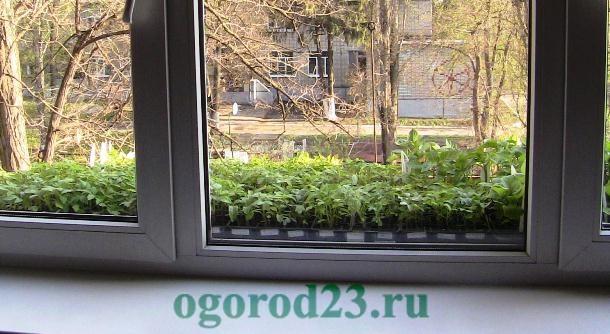
Hardening process outside the window
At what temperature should I place seedlings on the balcony? Before planting in the ground, it must be accustomed to outdoor conditions - hardened. These procedures should be started approximately two weeks before planting tomatoes for permanent residence. An open balcony for tomatoes is a great place where they adapt to the sun's rays and cold air.
When the day is warm (+12°C or higher), the seedlings can be opened and taken out into the fresh air - two to three hours in the first 2-3 days will be enough. After this period, it will be possible to leave it there all day. If you decide to leave it on the balcony overnight, it will be better if you cover it with film. The temperature at this stage should not be lower than +10°C; if the thermometer points downward, then do not hesitate, bring the seedlings into the house. An indicator that the bushes have hardened will be a slight purple tint to the foliage; do not forget to water them during the adaptation process.
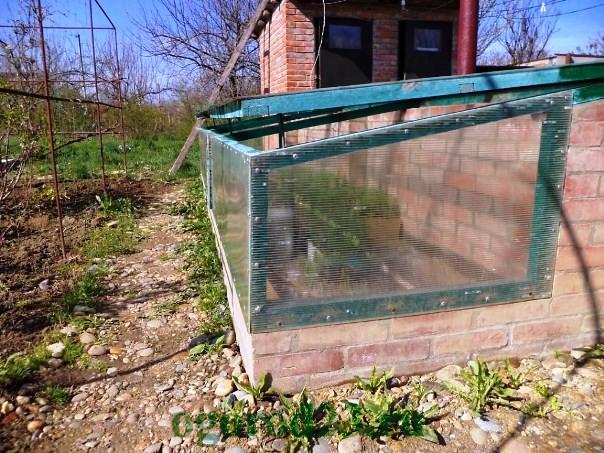
Greenhouse for hardening plants before planting in the ground
For the first few days, do not expose the plants to the open sun, they may get burned - the leaves will turn white.
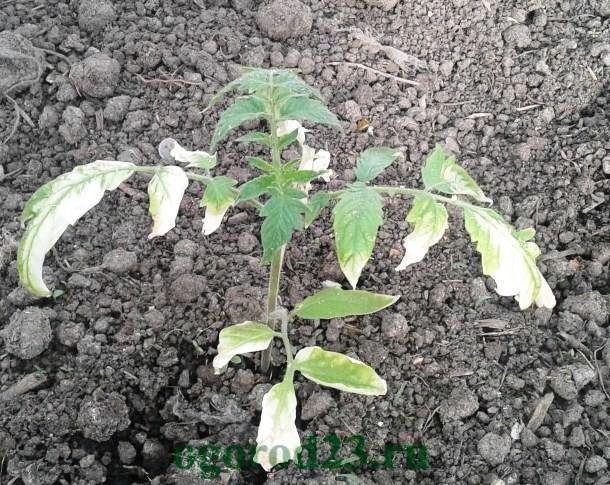
Sunburn of tomato leaves
The shadow is the best place for them at first. Rooted, strong seedlings can even withstand frost, while weak ones die immediately.
After 45-50 days from the moment the shoots emerge, the tomatoes are sent to the beds
Wait until a cloudy day to plant tomatoes in open ground - this is an important condition. They will easily take root, but the soil temperature must be acceptable (not lower than +12°C)
Air and soil temperatures are also important if tomatoes are pre-planted in a greenhouse. The soil under the film warms up quickly, two days will be enough. Thus, the temperature of the upper layers of the soil must not be lower than +10°C, otherwise the root system of plants will stop developing and begin to rot. Ideally, the soil temperature in the greenhouse for planting seedlings will not be lower than +15ºС. This is an acceptable level for the harmonious adaptation of plants in a new place and the development of new roots.
